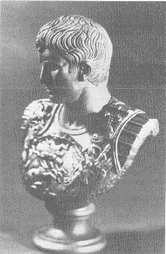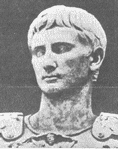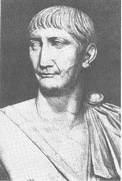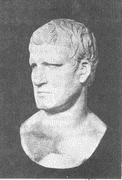We receive many letters about long hair. One man wrote that nobody living in the time of Jesus wore short hair. He also said that short hair was only a product of the last 150 years.
But is this true? What is the history of short hair?
Short hair has been with us far longer than most realize. It was the dominant, accepted mode for men in the time of Christ. Pick up any good illustrated history book on the period and you will see the evidence before your eyes. Two good books in this area are: A History of the Holy Land, Michael Avi-Yonah, editor, and Daniel to Paul, Gaalyahu Cornfeld, editor. Now notice the busts and statues of various Greeks and Romans of the time of Christ. The men are wearing their hair short on every one of them in a manner similar to that generally accepted today (minus the laurel wreath).
For example, on pages 126-127 of Avi-Yonah's work are found busts of Pompey, Augustus, and one believed to be Herod — all with short hair. All statues and carvings of Roman legionnaires show them with closely cropped hair. A Roman with long hair was an oddity as is . . . er . . . used to be the case for men in our society. In fact, ALL the Roman emperors before, during, and after the time of Christ, from Julius Caesar to Trajan, wore short hair. And the emperor was the individual who set the pattern in style and mode of dress for the whole empire.
 |
 |
 |
 |
Roman emperors set the style for the entire empire before, during and after the time of Christ. Neither General Pompey (upper left) nor the Emperor Trajan (left) wore long hair, nor did Julius Caesar (center) nor Caesar Augustus (upper right). King Herod Agrippa I of Judea (lower right), a Jew by religion, ruled shortly after the time of Christ.
Photo credits: Upper left, University Prints; Lower left, Historical Pictures Service; Center, Ambassador College; Upper right, PIP; Lower right, University Prints, Boston
|
 |
Prior to the coming of the Romans, it was the Hellenistic Greek culture which dominated the Eastern Mediterranean, and Judea by no means escaped. Even in Christ's day, a large segment of the Jewish population was Greek-speaking and Hellenistic in outlook. (See John 12:20; Acts 6:1) The Greek Hellenistic style for men was to wear the hair short (Cornfeld, pp. 15, 146). On page 146 of Daniel to Paul is a picture of a "marble statuette of an unidentified man of the Hellenistic period — a time of close contacts between the Jewish and Hellenistic civilizations in thought, art, and everyday life. Whether Jewish or Gentile, he evokes his age and environment." The man had short hair. But notice that the author, a learned historian and archaeologist, COULD NOT TELL whether the man was Gentile or Jewish. Why? Because the styles of the day were the same throughout the Near-Eastern region, and that included short hair!
What about the non-Hellenistic Jews? The Jewish Talmud, which is anti-Hellenistic, states that all priests should have their hair cut once every thirty days (Ta'anith 17a). These Jews were aware of the statement in Ezekiel 44:20: "Neither shall they shave their heads, nor suffer their locks to grow long." The Talmud further tells us exactly what hair style — the "Julian," or what we would call "a Caesar cut" (Sanhedrin 22b). And the priests were the religious leaders whom God intended to set the example for the community (Malachi 2:7). There are numerous other references to cutting hair in the Talmud.
Statues and other reproductions of the Jewish men from Christ's period are few because many Jews objected to them on religious grounds. But those few we do have again point to short hair as the style for men of the period (Cornfeld, p. 287).
Also, the following are sources in which you can find ancient pictures of known Jews having short hair.
1) Nathan Ausubel, The Book of Jewish Knowledge, Crown Publishers, New York, 1964, pp. 25-26. This shows Jewish conceptions of both David and Ezra — with short hair. They date from 250 A.D.
2) The Standard Jewish Encyclopedia, Cecil Roth, editor, Doubleday and Co., Garden City, New York, 1966, article "Art," p. 167. This shows Jews of the third century A.D. with short hair.
Additionally, pictures are available in many encyclopedias of both the bust and the coins of King Herod Agrippa I. This king, contemporary with the early apostles, is regarded by scholars as having been an observant Jew by religion. He, too, wore his hair short.
Under a Nazarite Vow?
Some have mistakenly assumed that Christ was under a Nazarite vow. This was not the case. Jesus Christ grew up in Nazareth (Matt. 2:23; Mark 1:9; Luke 1:26; John 1:45). The early Christians were sometimes called Nazarenes. But neither of these words have anything to do with a Nazarite vow. Notice that Jesus drank wine (Matt. 11:19). He also, on occasion, touched a dead body (Matt. 9:25). Both these actions were absolutely forbidden to anyone under a Nazarite vow (Num. 6:3, 6). Those under a Nazarite vow let their hair grow long as a token of humiliation: Today, those who wear their hair long are generally anything but humble. Usually, they wear long hair in defiance of society.
Notice too that as soon as the time period of the Nazarite vow was over, the one who undertook the vow was to shave his head! (Num. '6:18) The shameful period of the vow was over.
Now notice I Corinthians 11:14: "Doth not even nature itself teach you, that, if a man have long hair, it is a shame unto him?" It IS A SHAME for a man to have long hair! Nature shows this. A man's hair is just not designed to grow long. For one thing, it is not very manageable.
Also, Jesus Christ — the Word (John 1:1) — inspired the Bible. "All scripture is given by inspiration of God" (II Timothy 3:16). Since Jesus Christ inspired I Corinthians 11:14, He did not contradict His own Word by wearing His hair long.
Publius Lentulus
Some readers have asked us about the Report of Publius Lentulus which describes Jesus as having long hair. This report was supposedly written by the Roman governor of Judea to the Emperor Tiberius. But accurate historical records of the Roman governors at that time are still in existence. There was no governor of Judea by the name Publius Lentulus during the time of Jesus Christ (the governor was, of course, Pontius Pilate).
Professor Edgar J. Goodspeed, well known Biblical scholar writes:
The `Letter of Lentulus' is evidently a fiction, designed to give currency to the description contained in the painters' manuals about the personal appearance of Jesus. . . . It is probably as old as the thirteenth century; but it was unknown to Christian antiquity, and has no claims to serious attention as throwing any light upon the personal appearance of Jesus (Modern Apocrypha, p. 91).
What Christ Looked Like
We are nowhere told to be concerned with exactly what Jesus Christ looked like, as a human being. The Bible gives no exact description. But we are told, "He hath no form nor comeliness; and when we shall see him, there is no beauty that we should desire him" (Isa. 53:2).
Yet Jesus looked like any other normal Jew of His day! On a number of occasions He was able to pass through crowds because He looked just like anyone else (Luke 4:30; John 8:59; 10:39). Judas had to use a special sign, a kiss, to point out to Jesus' enemies which one He was. Judas would not have had to do this if Jesus had had long hair.